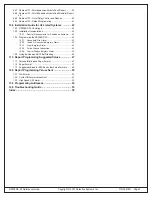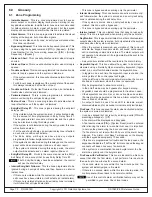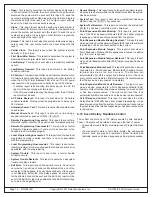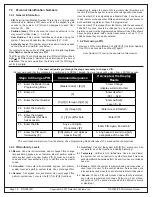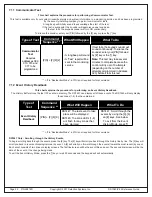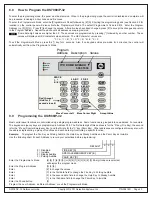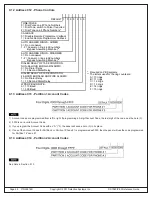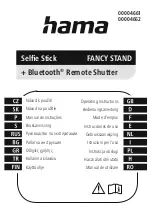
Page 14 P/N 39818D Copyright © 2001 Detection Systems, Inc. DS7080iP-32 Reference Guide
• Open: This report is sent when the system has been disarmed.
In SIA or Contact ID formats, the user number for the person who
disarmed the system will be sent with this report. To send the
user number along with an Open report in other formats, program
the extended digit of the report as *5. The Open report will only
be sent if a Close report was sent previously.
• Close: This report is sent when the system has been armed. In
SIA or Contact ID formats, the user number for the person who
armed the system will be sent with this report. To send the user
number along with a Close report in other formats, program the
extended digit of the report as *5.
• Duress: This report is sent when the system is disarmed using a
duress code. The user number will not be sent along with this
report.
• Partial Close: This report is sent when the system is armed
partially, or force armed.
• First Open After Alarm: This report is sent when the system is
disarmed after a burglar alarm has occurred.
• Low Battery: This report is sent when a low battery condition
occurs.
• Low Battery Restoral: This report is sent when a low battery
condition restores.
• AC Failure: This report is sent after an AC failure condition occurs.
AC failure reports will either be sent along with other reports or
when the AC Fail Timer (Address 026) runs out. The AC power
loss report can be programmed to delay for up to 255 minutes.
- If another report is sent during this delay period, the AC fail
report will be sent along with this report.
- If the AC power restores during the delay period, the AC Failure
report will not be sent.
• AC Failure Restoral: This report is sent when an AC failure
condition restores. This report can be programmed to delay up to
255 minutes.
• Automatic Comm. Test: This report is sent at the predetermined
check-in time.
• Manual Comm. Test: This report is sent at any time using a
keypad command sequence of [PIN] + [#] [8] [2].
• Remote Programming Successful: This report is sent after a
Remote Program session, if the session was terminated properly.
• Remote Programming Unsuccessful: This report is sent after
a Remote Program session, if some error has occurred or the
session did not terminate properly.
• Local Programming Successful: This report is sent when local
programmer’s mode is exited and there is no error associated
with the programming.
• Local Programming Unsuccessful: This report is sent when
local programmer’s mode is exited and there has been some error
associated with the programming.
• System Trouble: This report is sent when a control trouble
condition occurs.
• System Trouble Restoral: This report is sent when all system
trouble conditions restore.
• Exit Error: This report is sent if an exit error occurs. An exit error
occurs when an entry/exit zone is still violated at the end of the
exit delay. If this happens, the entry delay will begin. If the system
is not disarmed before the entry delay expires, an alarm report
for the affected zone will be sent and the Exit Error report will be
sent. If the Exit Error report is enabled then the Bell Output will go
on to warn the departing user.
• Recent Closing: This report is sent, along with any alarm reports,
when there is an alarm within the first five minutes after the system
has been armed.
• System Test: This report is sent when a system test has been
started using the [#] [8] [1] key sequence.
• System Test Restoral: This report is sent when the system test
([#] [8] [1]) has been completed or has timed-out.
• Point Expansion Module Missing: This report is sent when
one of the Point Expansion Modules (EX8) has either stopped
responding or has been disconnected from the system.
• Point Expansion Module Missing Restoral: This report is sent
when a missing Point Expansion Module (EX8) has either started
responding or has been reconnected to the system.
• Point Expansion Module Tamper: This report is sent when a
Point Expansion Module (EX8) experiences a tamper condition
(e.g. the cover is opened).
• Point Expansion Module Tamper Restoral: This report is sent
when a Point Expansion Module (EX8) tamper condition has been
cleared.
• Point Expansion Module Fault: This report is sent when a device
connected to a Point Expansion Module (EX8) Auxiliary Output
terminal has drawn too much current. The Module will
automatically shut off the output and attempt to turn it back on
every minute until it restores. If this fault occurs, it is recommended
that the device be disconnected immediately.
• Point Expansion Module Fault Restoral: This report is sent
when a device connected to a Point Expansion Module (EX8)
Auxiliary Output terminal has stopped drawing too much current
or has been disconnected. The module will reset the fault
automaitcally within one minute once the device is disconnected.
• Octal Relay and Control: This report is sent when the Octal
Relay Module (DS7488) has either stopped responding or has
been disconnected from the system. A restoral report is sent when
the module has either started responding or has been reconnected
to the system.
6.15 Event History Readback Control
The control can store up to 100 history events by time and date.
These 100 events will be retained even upon the loss of power.
- The events stored in history are determined at Program Address
027.
- You may select to store or not to store: burglar, fire, and keypad
alarms; zone troubles and restorals; system troubles and
restorals; opens and closes; bypasses; and program accesses.



